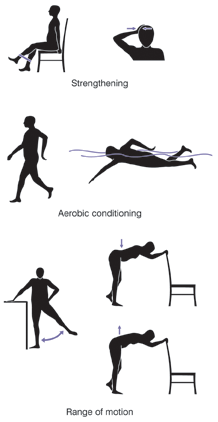Although health care professionals can prescribe or recommend treatments to help you manage your arthritis, the real key to living well with the disease is you.
Research shows that people with osteoarthritis who take part in their own care report less pain and make fewer doctor visits. They also enjoy a better quality of life.
Living well and enjoying good health despite arthritis requires an everyday lifelong commitment. The following six habits are worth committing to:
Get Educated
To live well with osteoarthritis, it pays to learn as much as you can about the disease. Three kinds of programs help people understand osteoarthritis, learn self-care, and improve their good-health attitude. They are:
- patient education programs
- arthritis self-management programs
- arthritis support groups
These programs teach people about osteoarthritis, its treatments, exercise and relaxation, patient and health care provider communication, and problem solving. Research has shown that people who participate in these programs are more likely to have positive outcomes.
Stay Active
Regular physical activity plays a key role in self-care and wellness. Four types of exercise are important in osteoarthritis management. The first type, strengthening exercises help keep or increase muscle strength. Strong muscles help support and protect joints affected by arthritis. The second type, aerobic conditioning exercises improve cardiovascular fitness, help control weight, and improve overall function. The third type, range-of-motion exercises, help reduce stiffness and maintain or increase proper joint movement and flexibility. The fourth type, balance and agility exercises, can help you maintain daily living skills.
You should start each exercise session with an adequate warm-up and begin exercising slowly. Resting frequently ensures a good workout and reduces the risk of injury.
Before beginning any type of exercise program, consult your doctor or physical therapist to learn which exercises are appropriate for you and how to do them correctly, because doing the wrong exercise or exercising improperly can cause problems. A health care professional can also advise you on how to warm up safely and when to avoid exercising a joint affected by arthritis.
 Exercises for Osteoarthritis
Exercises for Osteoarthritis
Research has shown that exercise is one of the best treatments for osteoarthritis.
Exercisecan decrease pain, increase flexibility, strengthen the heart, and promote general physical fitness. In addition, it has benefits for improved mood and outlook.
If done correctly, exercise has few negative side effects. The amount and form of exercise prescribed will depend on which joints are involved, how stable the joints are, and whether a joint replacement has already been done.
Walking, swimming, and water aerobics are a few popular types of exercise for people with osteoarthritis. Your doctor and/or physical therapist can recommend specific types of exercise depending on your particular situation.
The following types of exercise are part of a well-rounded arthritis treatment plan.
- Strengthening exercises: These exercises strengthen muscles that support joints affected by arthritis. They can be performed with weights or with exercise bands, inexpensive devices that add resistance.
- Aerobic activities: These are exercises, such as walking or low-impact aerobics, that get your heart pumping and can keep your lungs and circulatory system in shape.
- Range-of-motion activities: These keep your joints limber.
- Agility exercises: These can help you maintain daily living skills.
You should start each exercise session with an adequate warm-up and begin exercising slowly.
Resting frequently ensures a good workout and reduces the risk of injury.
Before beginning any type of exercise program, consult your doctor or physical therapist to learn which exercises are appropriate for you and how to do them correctly, because doing the wrong exercise or exercising improperly can cause problems.
Ask for guidelines on exercising when a joint is sore or if swelling is present. Also, check if you should (1) use pain-relieving drugs, such as analgesics or anti-inflammatories (also called NSAIDs or nonsteroidal anti-inflammatory drugs) to make exercising easier, or (2) use ice afterward.
Eat Well
Though no specific diet will necessarily make your arthritis better, eating right and controlling your weight can help by minimizing stress on the weight-bearing joints such as the knees and the joints of the feet. It can also minimize your risk of developing other health problems.
Get Plenty of Sleep
Getting a good night’s sleep on a regular basis can minimize pain and help you cope better with the effects of your disease. If arthritis pain makes it difficult to sleep at night, speak with your doctor and/or physical therapist about the best mattress or comfortable sleeping positions or the possibility of timing medications to provide more pain relief at night. You may also improve your sleep by getting enough exercise early in the day; avoiding caffeine or alcoholic beverages at night; keeping your bedroom dark, quiet, and cool; and taking a warm bath to relax and soothe sore muscles at bedtime.
Weight Control
If you are overweight or obese, you should try to lose weight. Weight loss can reduce stress on weight-bearing joints, limit further injury, increase mobility, and reduce the risk of associated health problems.
Have Fun
Although having osteoarthritis certainly isn’t fun, it doesn’t mean you have to stop having fun. If arthritis makes it difficult to participate in favorite activities, ask an occupational therapist about new ways to do them. Activities such as sports, hobbies, and volunteer work can distract your mind from your own pain and make you a happier, more well-rounded person.
Some approaches might include:
- Focus on your abilities instead of disabilities
- Focus on your strengths instead of weaknesses
- Break down activities into small tasks that you can manage
- Incorporate fitness and nutrition into daily routines
- Develop methods to minimize and manage stress
- Balance rest with activity
- Develop a support system of family, friends, and health professionals.
Source: National Institute of Arthritis and Musculoskeletal and Skin Diseases
Last updated : 11/17/2022